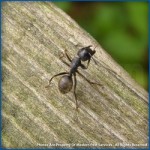
April is National Pest Month and Modern® Pest Services wants to warn people about carpenter ants. Carpenter ants are social insects that usually nest in wood and start to appear in Maine, Massachussets and New Hampshire in April.
Carpenter ants can cause severe property damage
“Carpenter ants become active this time of year and can cause a lot of property damage by weakening and destroying wooden structures,” said Mike Peaslee, Technical Manager at Modern Pest Services. “The common misconception occurs when people see carpenter ants in their house around this time of year for just a few weeks and then they seem to disappear. However, as it gets warmer the carpenter ants’ feeding patterns change and they start to forage outside. People don’t think it’s a problem anymore but actually the ants are still nesting in their house.”
Carpenter ants range in size and color
Carpenter ants can cause serious damage to structural timbers by excavating out cavities to build nests, raise their young and expand their colonies. All species mainly attack wood that is or has been wet and/or damaged by mold but carpenter ants don’t eat any of the wood they excavate, preferring sugar solutions from honey dew-producing insects such as aphids. They are commonly black but some species are red and black, solid red or brown or a combination of these colors. Their sizes ranges from 1/8” to 1/2” long, but the queens are slightly larger.
Signs that you may have carpenter ants:
- Sawdust piles. Carpenter ants are meticulous and will remove sawdust away from their nest and dump it into piles. You may find these small sawdust piles near where they live.
- Wet wood. If you have had water damage or water leaks at your property, take note: carpenter ants like moisture and prefer to excavate wood damaged by fungus which is often the result of moisture problems.
- Noise in your walls. Rustling sounds in wall voids are another indication that there may be a carpenter ant colony in the area. The noise is frequently described as sounding like cellophane crinkling.
- Annual springtime visitors. If you see ants in your house on a consistent basis every spring, it’s highly likely you have a nest.
Carpenter ants nest in different areas in and around the house
There are several areas where carpenter ants are usually found including: windows, window sills and frames, doors and door frames, adjacent to plumbing fixtures, attics, crawl spaces, porch supports, steps, under patios and decks, and around gutters and downspouts. If carpenter ants are suspected, a pest management professional (PMP) should be contacted for a thorough inspection to determine the extent of the infestation and then a treatment strategy and follow up plan should be discussed.
Treatment for carpenter ants includes finding their nest(s)
The treatments for carpenter ants vary depending on the situation. PMPs look for the main nest which is where the carpenter ant colony lives. The ants tend to spread out and have satellite nests which are typically located inside a home. However, the main nest is usually outside in a tree stump or other areas near the structure and should be treated with an insecticide if found. The perimeter of the structure is also treated with the insecticide to help reduce further infestation, while the inside nest is treated with bait and dust products. If the PMP can’t locate the main nest they will treat using baits and dust in areas of the structure conducive to an infestation and will also make a perimeter application.
The National Pest Management Association (NPMA) celebrates April as National Pest Management Month, an observance that has been recognized by the President of the United States for nearly 30 years. National Pest Management Month salutes the professional pest control industry for playing a key role in protecting both health and homes from significant pest-borne threats.
If you think you may have a carpenter ant issue, please call Modern Pest Services at 1-800-323-7378.
